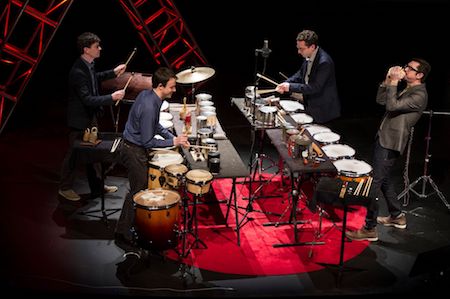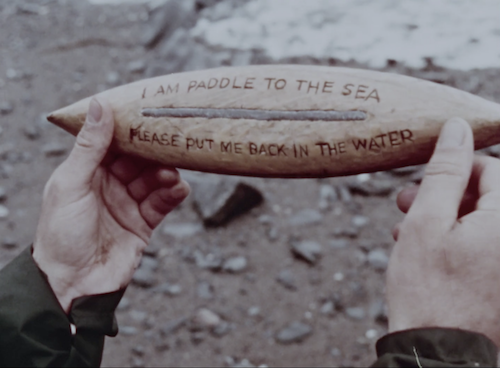by Jarrett Hoffman

That’s the tale of Bill Mason’s beautiful film Paddle to the Sea (1966), based on an award-winning children’s book and nominated for an Oscar. You can watch the 28-minute movie here, via the National Film Board of Canada. But you’ll want to take it in again this weekend, when a Chicago-based, Grammy-winning percussion quartet visits the Cleveland Museum of Art.
On Sunday, February 11 at 2:00 pm at Gartner Auditorium, Third Coast Percussion (David Skidmore, Robert Dillon, Peter Martin, and Sean Connors) will give a live performance of their new, original score alongside a screening of Paddle to the Sea. The work is a co-commission of CMA. Part of the Museum’s , the concert will also include water-related works that influenced the score: pieces by Philip Glass and Jacob Druckman, as well as traditional music of the Shona people of Zimbabwe. You can reserve tickets here.

From there, a draft of a section would be passed on whenever someone felt stuck, or when somebody had an idea. “Then they would work on it for a while and come back with a different version of it.”
This was Third Coast’s second collaborative composition, following up on their 2016 piece Reaction Yield. Dillon noted that the process had evolved from that project to this one. “For Paddle to the Sea, there was more revising of sections that other people had worked on. Each of us had responsibility for certain segments of the film, but at the end of the day it’s hard to say, ‘This section was Rob’s,’ or ‘This was Peter’s.’ Things got marbled through more and more.”
Busy with their self-run ensemble, Third Coast’s members don’t often have time to write music, which is one reason they enjoyed this project. “It was guaranteed there would be time for composing, because we had to.” Dillon added that the joint process also made composing feel less daunting. “You knew you weren’t trying to figure it all out yourself. If you had a good idea you could bring it to the table, and even if you didn’t know where to go with it next, maybe it would inspire someone else to take it and run with it.”
Has the collaborative approach impacted the group in any way? “This was one more thing that’s gotten us excited about the work we do together as an ensemble. It’s made us feel, even more than before, that we’re all creative stewards of this organization.”
For Sunday’s performance, the winds, strings, and piano of the original soundtrack will be replaced by marimba, vibraphone, almglocken (tuned cowbells), drum set, and synthesizer, as well as an assortment of sonic knick-knacks: pitched desk bells, wood blocks, ceramic floor tiles, mbira (thumb piano), and a water-filled bowl with a submerged microphone, to name a few.
But there was more to consider with this project than the music. Anyone who’s seen Paddle to the Sea will know that an old-fashioned voice provides gentle narration throughout, and that environmental sounds crop up as well. How did Third Coast tackle those aspects of the soundtrack?
“We used the sound of waves in very specific spots that fit with the movie but also tie the beginning and the end together,” Dillon said. “Other than that, we have no atmospheric sounds.” Ultimately, with the help of Chicago-based stage director Leslie Danzig, the group decided to keep the narration in their educational version for young people, but to omit it for an adult audience.
“We were a little nervous about that at first, but all of the action in the movie speaks for itself,” Dillon said. “I think the lack of narration lends an air of mystery to it. It feels less like a children’s film — less like we’re playing a soundtrack, and more like a performance experience.”
The project examines water in terms of geography, economics, culture, and environment. To close our conversation, I asked Dillon to share what water means to him. “It gives definition and shape to the world,” he said. “Large bodies of water are like mountains in the sense that they’re bigger than anything in your daily life, more vast than you can fully conceive of. But even with smaller bodies of water, as land-dwelling creatures we spend our entire lives not thinking about the whole world that exists below the surface — it’s this alternate reality, an entirely different universe.”
Sunday’s program also outlines Third Coast Percussion’s latest album, Paddle to the Sea, available this Friday.
Published on ClevelandClassical.com February 6, 2018.
Click here for a printable copy of this article





